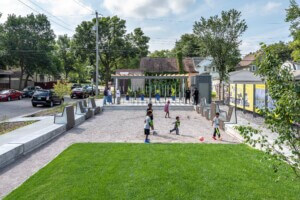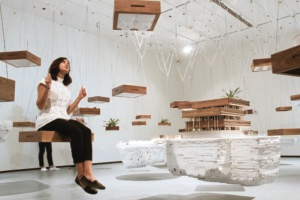As part of AN’s series of profiles with 2022 Emerging Voices winners, Editor-in-Chief Aaron Seward sat down with architect Sekou Cooke to discuss his career, approach to design, and work with Hip-Hop Architecture.
The following interview has been edited and condensed for clarity.
Aaron Seward: How did you come to architecture to begin with? What was the impetus for you to take this path in life?
Sekou Cooke: I was about five years old when I decided I wanted to become an architect. I could draw and I was one of those kids who took things apart to see how they worked. My grandmother told me about these people who draw buildings and I thought, ‘sure, that sounds like a good idea.’
Later, my sister [Nina Cooke John] got into architecture, and she paved the way for me to find out what architecture school was all about. She got into Cornell and helped me get into Cornell. I still didn’t know what architecture was and I graduated from Cornell still trying to figure it out. It was really in practice that I understood the impact and repercussions of the things I was drawing on paper. I remember the first time. I had been drawing these shelves on Autocad for weeks and not understanding why my boss was fussing about a quarter-inch here, a quarter-inch there, and a couple months later, I saw a photograph of those shelves in the building it was designed for and I was like, “wow, I can’t believe this.” That was the big epiphany for me that all this stuff is great and fun to talk about and it keeps our minds busy but until it gets into the real world it doesn’t really count for anything. I’m still figuring out what architecture is.
That’s interesting because there is a theoretical arm of your practice. You compare it to Koolhaas’s AMO division…
(Laughter) Very hubristically.
I think I agree with you that building is the ultimate end of architecture, and that’s where you really see what it’s all about, but at the same time, you seem very dedicated to the idea of theory and developing new ideas for architecture.
To be clear, I don’t see building as the ideal end for architecture, I see building as its testbed. This is where we see how it operates in the real world. My first semester at Harvard I got to work with Ben van Berkel. I would take our one-hour sessions and talk to him about architecture. We would talk about the idea that a building is one of the least satisfying products of architectural exploration. This is why a lot of people get so seduced by all of the discourse within architecture and remain in that realm. For me, I have to bring it into the real and test it to understand it more so that I can then add more to the theoretical and research so I can move those ideas forward.
The AMO example is intriguing because those are ideas and theories that Rem and his cohort laid out for years and years, sometimes decades, before they were tested and then the practice gets built around that.
AMO as a research arm operates independently from the practice. For me those two things are always intertwined and have to always be feeding off each other. I am invested in creating new ideas and theories for architecture because I see what happens in the practice and I know that it’s not enough. It’s not serving all of the right people, it’s not serving all of the right interests. We’re deeply embedded in this capitalist framework that architecture hasn’t seemed to find its way out of.
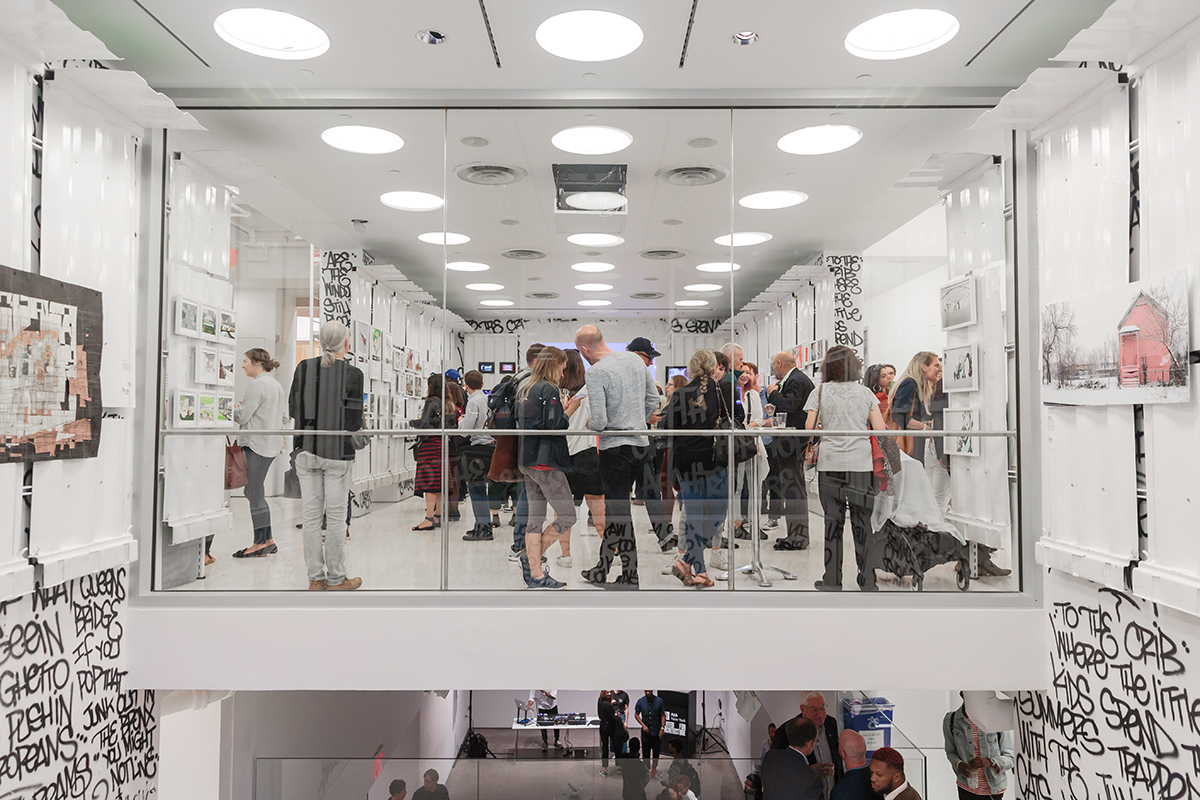
Could you think of an example from your own work that shows this feedback loop of theory and practice?
A lot of my early career was doing high-end homes for people in Manhattan and the outer boroughs. That was a great training ground for understanding how things are put together, the relationship between design and putting something on paper and getting something built, and how facile you have to be when talking to clients, selling your ideas, talking to contractors, reinterpreting your ideas, talking to the officials that review the drawings and convincing them that what you’re doing is within the scope of the regulations.
There are so many logistical and tactical hurdles that you have to jump over to get something built. It was important to me, but then I realized that that type of mindset already exists in so many different communities, but not the communities that I was serving when I got into private practice. I was eventually drawn to nonprofit organizations that had nothing but hurdles in front of them. They didn’t have funding, which was the number one thing, and they didn’t have their owner’s rep who was going to translate all of this architectural stuff to them, and layout things like a program or a budget, or have a very good understanding of what type of project they’re hiring me to deliver. I had to educate clients, develop clients.
[Take] the food coop project in Syracuse. It was being developed by a community organization and a university-based initiative so no one on the team knew anything about development or acquiring property, or about contractors, or engineers, or design. The process was a process of educating the client and shaping the project at the same time. So, you are invested in understanding and exploring all the realms of all these logistical challenges that are in front of you just to get out of design.
I realized that personal taste had to take a side step and it became more important to invest myself in a larger movement that would direct and influence what the thing looked like more than just my own personal whims. In future projects, like the SHHHQ project in Syracuse, the Syracuse Hip-hop Headquarters project, or a project that I’m developing now and have been working on with a church group for the last three years for a family life center, also in Syracuse—these are projects where I am helping the client understand the logistical landscape but also creating and developing a theoretical landscape within which I can work.
Could you speak specifically about the history of Hip-Hop Architecture and where you come into it?
The first time I heard about Hip-Hop Architecture was in 1994 when I first started undergrad at Cornell. Nate Williams had done his thesis project two years before and people were still talking about it, still trying to figure out how they could incorporate these ideas into their projects. Nate had done this thing that I describe in detail in the book: he transformed the presentation room into a party. He had a DJ live mixing for a half-hour before his presentation started. He described how all these elements of the culture that he had invested his young life in were applicable to architecture and could create a specific kind of architecture that, for him, was making use of spaces that people had forgotten and thrown away but could be elevated to some of the most desirable spaces within the hip-hop community.
Most of the education was based in Colin Rowe and Simon Ungers and Le Corbusier and Michael Graves. This is what we were learning and trying to emulate over the first four years of our architectural education. The last year was the only space we had to bring any sort of agency to our projects. So that’s what Nate did and that’s what a series of us did after that. We had this powerful critical mass moment at Cornell in the ’90s, where instead of having just one or two Black people per class, as happened in most schools, and still happens in some schools today, we had a director of minority affairs, Ray Dalton, who was able to bring cohorts of six, seven, or even eight Black or brown people into that space of 60 or 70 people per class.
We were getting closer to the national demographics. We never hit the national demographics, but we were getting closer to that. We had this critical mass of people who could talk about these issues, who could exchange ideas, a think tank, an incubation space for these ideas about hip-hop and architecture that lasted for all five years while I was there. Then it took until I was in grad school 13 years later for some of those ideas to start coming back up. For me, I decided if people are going to talk about this again it would be cool for me to show what my perspective is having experienced some of the early genesis of these ideas back in the 90s.
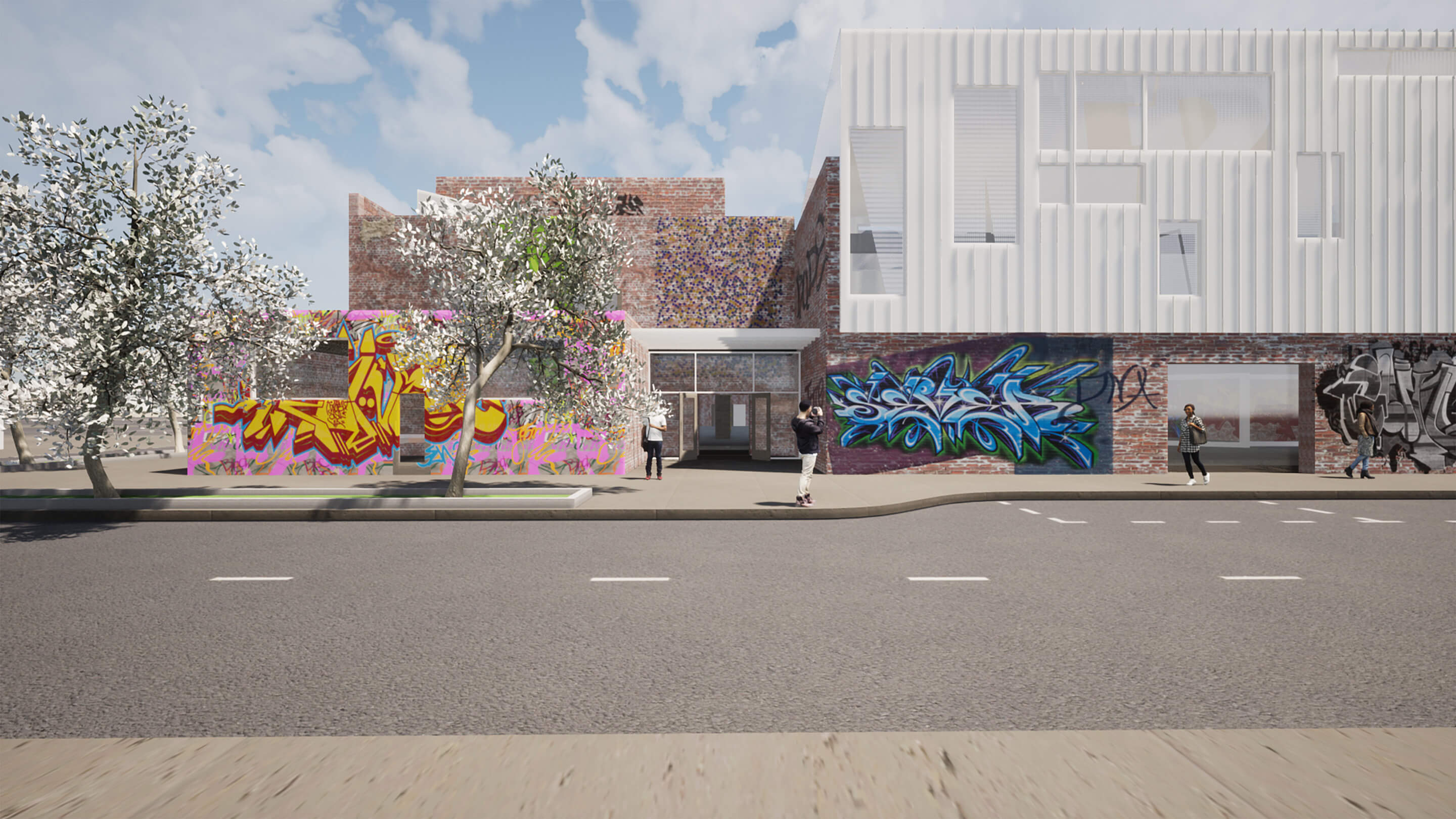
So, I wrote this one essay published in the Harvard Journal of African American Public Policy in 2014, “The Fifth Pillar: The Case for Hip-Hop Architecture.” I was trying to make a singular case for positioning architecture within the realm of all the hip-hop elements and saying that it can be a viable product of hip-hop culture. It really was supposed to be a one-off thing, like, “okay I’m doing this I’ve got the ideas out of my head, it’s out, now I can move on with my life.” And that piece then got picked up by ArchDaily and got a lot of national attention and from people who had been writing about the topic. I didn’t know about Craig Wilkins until after that. He directed me to some of his writing and I realized there is a greater body of knowledge here, a greater body of people who are interested in this and talking about this.
In 2015 I put together a symposium at Syracuse University and invited all of the people who were talking about Hip-Hop Architecture that I knew about at the time. We had 12 participants for two days, five different sessions, and that was supposed to be the, “okay, now I’m done with this topic, here it is, leave me alone now.” But that symposium brought up more questions than it answered and convinced me that the topic had legs. Luckily it was at the beginning of my tenure track and I needed to have a primary research topic for the next six years and I was like, “either this or talk about digital fabrication.”
So that’s what I ended up doing. I invested myself in the topic instead of initially doing my own explorations. My first step was to curate the topic, to understand what people were doing and the 20-plus years of work that people have been producing on the topic since the mid-90s and gather as much of that as possible. That’s what led to the first exhibition in 2018 at the Center for Architecture, where I had 25-plus participants in that show and brought in work from eight different countries across that 26-year timespan at the time. The show itself was a design exercise in Hip-Hop Architecture.
Have you found a specific architectural language that represents hip-hop or is it more about a process?
It’s absolutely about process. I broke down the work in the show under three headings: Image, Process, and Identity. Work that looked like things that people may associate with hip-hop ideas or hip-hop visuals, like hip-hop fashion or graffiti or hip-hop style, and others where the authors themselves identify with hip-hop culture, so their projects somehow show that identity. But the process is where we start to understand the parallels between the other products of hip-hop culture and architecture are. This is where you can see some of the thematic pieces, like layering as a device or tool that we see in graffiti and hip-hop music, the layering of tracks, sampling, the respect and the honorific given to whatever is existing, what was there before, what had come before, and then elevating it to a new level, which we sometimes call remixing.
Improvisation within every other aspect of hip-hop culture is essential, but when it comes to architecture it is almost impossible. When we find moments of improvisation within the design or the construction process that’s where we start to get to something quite powerful. The process part is incredibly important because what the results are don’t look like each other. The image doesn’t really matter. This is what the exhibition showed, and this is what the book shows, that it can look like almost anything because there’s no standard checklist of elements that you have to have in a building to qualify it as a Hip-Hop Architecture building. In that way, Hip-Hop Architecture is definitively not a style. It’s not a style like art deco is a style.
Designing for a specific style is always mimicking what that thing looks like, it doesn’t embody the materials, the technologies, the processes, the ideas, or the identity that those things did. Process by itself is incredibly powerful but it requires an understanding of hip-hop identity, understanding the cultural identity that’s a part of hip-hop, and then not necessarily having to personally identify with hip-hop culture, but understand your own identity relative to hip-hop culture, so that the work that you produce is reflective of a specific attitude or relationship that you have to the culture.
You’re based in Charlotte, North Carolina, where you’re the director of the Master of Urban Design program at UNC Charlotte. How are you liking it there?
It’s a lot warmer than Syracuse. It’s a bigger city, so there’s a lot more going on more that’s directly accessible and a lot more opportunities. What’s been most fascinating is the way that people are responding to my arrival here; they’re excited about what I’m going to be doing for the city. I didn’t think that I had the capacity to affect an entire city by myself, but I think this program and the ideas that I’m trying to use to transform the program are ideas that are potentially transformative on the city scale.
Charlotte has a recent history of removing historically significant structures and clearing large sections of the city in favor of new development. Our program will champion efforts to treat as much of the existing built fabric of the city as valuable. I’m not suggesting a radical preservationist approach but an approach that might be best thought of as radical adaptive reuse. I’m also interested in tactical urbanism as an attitude for operating within the city.
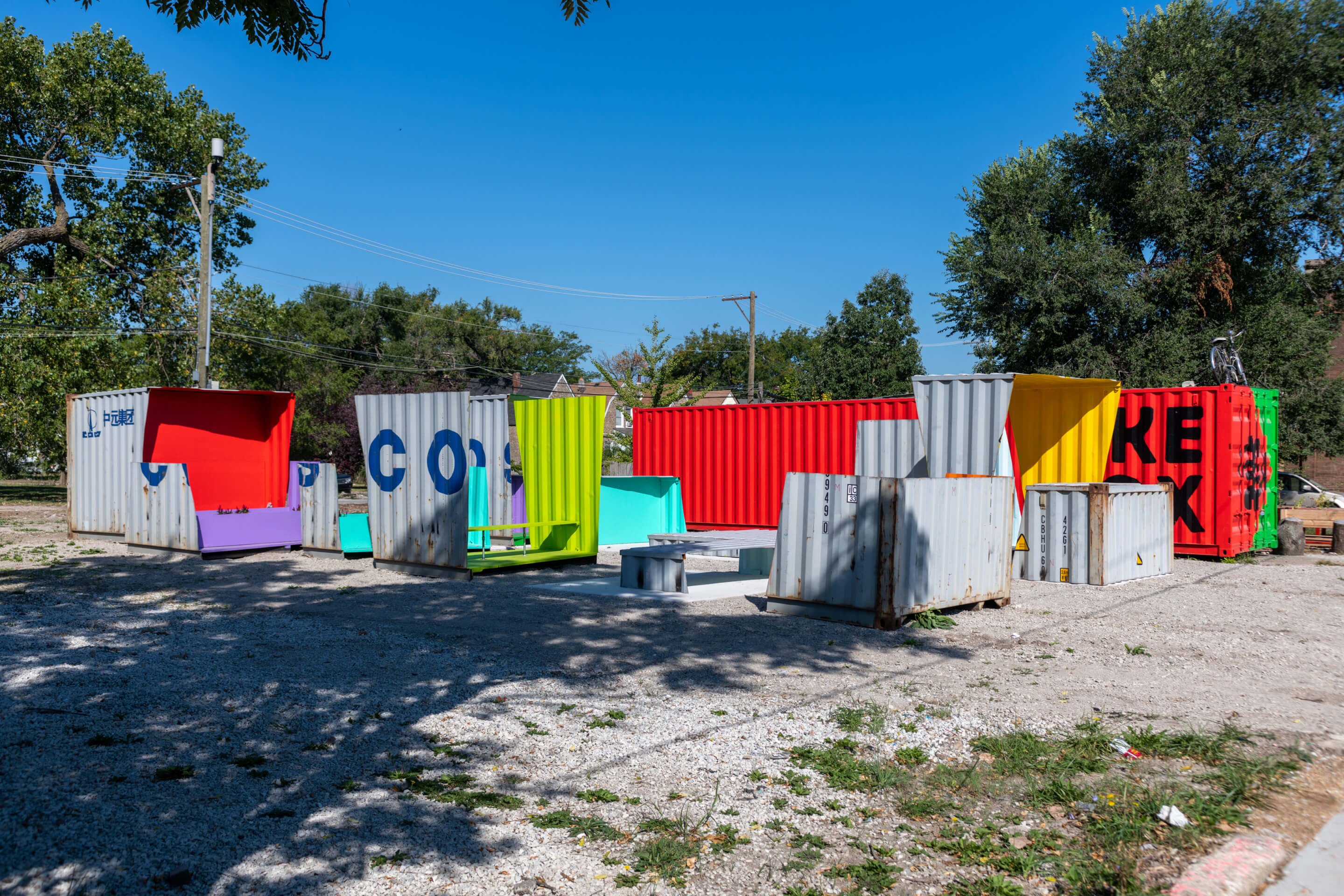
Architecture school, like the profession, has had representation problems. Over the past few years, a lot of attention has been drawn to the continuing inequality in our society and I’m wondering if you’re starting to see any improvement in demographic disparities at the level of architecture schools.
It’s difficult for me to have a clear perspective on it because of moving schools. The demographics are already different and have been different for a while, so when I have a class with three Black students in it I’m like, “oh my god that’s amazing” because it’s something I’ve never had before, but it’s par for the course here.
When I was at Syracuse, I was lucky to have one in my class. Two was almost impossible. It happened once or twice. I think none of those specific demographics are going to change overnight. I think what we’re talking about is a complete shift in mindset that is like turning around an oil tanker and it’s going to take time. I think I have put less personal energy into trying to shift the demographics of the practice and more into just changing the conversation completely in terms of what are the topics we teach, how do we teach them, and the realities that we’re expecting students to acknowledge. The content is really important. Having people who have been doing really great work become recognized and elevated at different levels. I’ve been seeing a lot more of that happening. I’ve been seeing recognition being given to more faculty of color.
Some of that seems to be that shift in mindset that I’m talking about, understanding that the work we do is at least as valuable as the work that our white counterparts do. At the student level, the hurdles are much higher because, one, we have to shift from a meritocracy to just get into college and two, we have to understand the decreasing relevance of university education within our society in general. Then we have this huge hurdle to make architecture this thing that kids of underprivileged backgrounds want to invest their college education in. It’s not just a numbers game. It’s so much more complicated than that.
Where would you like to see your practice move in terms of the types of projects you’re working on?
I’d just like to see things get built. It’s as basic as that. I say in the book that I’m not a hip-hop architect, I’m not even a Black architect, I’m an architect and primarily I want to identify as an architect. To me that means someone who can develop complex ideas and get them built and tested in the real world. There are many avenues towards that, and some are avenues I’ve chosen not to simply answer every single government RFP and do a bunch of local or state government work.
I’d like to say that I’ve chosen not to work for independently rich elite individuals though that’s not true because they’re just not the ones in my network so they’re not seeking me out to hire me. I have worked for friends who are wealthy and done private work for them, so I’m not opposed to that. But I’d like to think that I’ve chosen to develop a practice that is relevant to the people that I’m designing for, that they understand the power of design in their communities, they understand that there is a whole way of creating identity that is possible, so working for nonprofits, working for community organizations, working for startup companies, working for places of innovation, places that are trying to change some kind of narrative in some way.
I like to work within spaces of power so the design has some responsibility to reflect that power. I’d like to keep working within those realms, but at a certain level I’d like to not have to become an expert fund raiser for all the projects that I do. I’d like to work for well-funded, culturally progressive communities.








